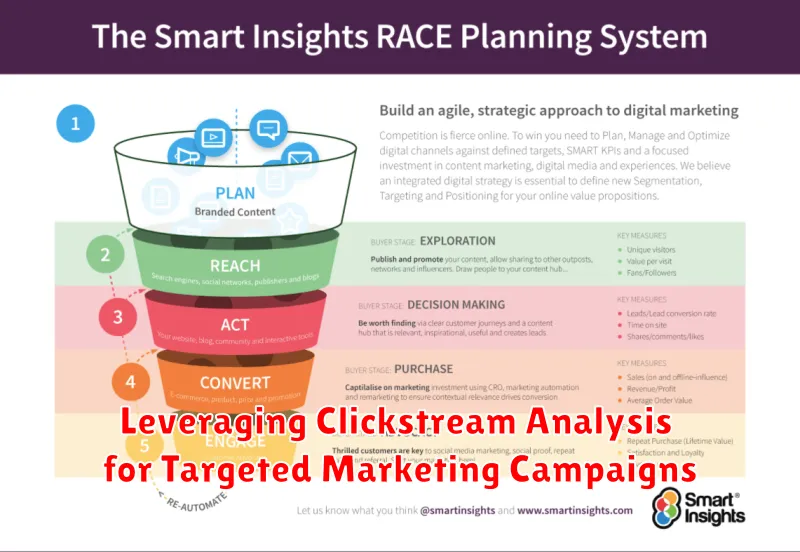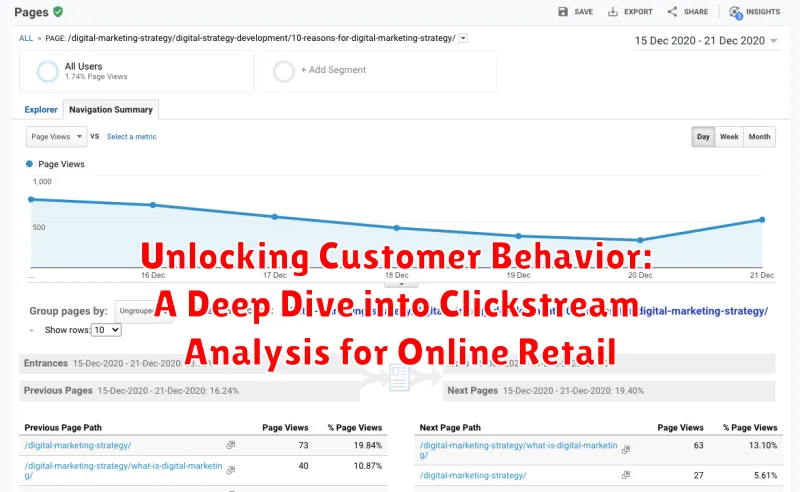In today’s highly competitive online retail landscape, understanding customer behavior is no longer a luxury, but a necessity. Clickstream analysis offers a powerful tool for businesses to gain deep insights into how customers interact with their online stores. By examining the digital footprints left by customers as they navigate websites and apps, retailers can unlock valuable information about browsing patterns, product preferences, and purchase decisions. This data-driven approach empowers businesses to optimize website design, personalize the customer experience, and ultimately, drive conversions and revenue growth.
This article provides a comprehensive deep dive into the world of clickstream analysis for online retail. We will explore the key benefits of leveraging clickstream data, discuss the various techniques employed in collecting and analyzing this valuable information, and showcase practical applications of clickstream insights to improve customer engagement, enhance marketing effectiveness, and achieve a significant competitive advantage in the dynamic world of online commerce. Join us as we unlock the secrets to understanding customer behavior through the power of clickstream analysis.
What is Clickstream Analysis and Why is it Important for Online Retailers?
Clickstream analysis is the process of collecting, analyzing, and reporting aggregate data about which pages a website visitor visits, and in what order. It provides valuable insights into user behavior on a website. Think of it as following a customer’s digital footprints as they navigate your online store.
For online retailers, clickstream analysis is crucial for understanding how customers interact with their website. By examining these patterns, businesses can identify areas for improvement in website design, product placement, and marketing strategies. It helps answer key questions, such as: Which products are customers most interested in? Where are they dropping off in the purchase funnel? What are the most common navigation paths?
By leveraging clickstream data, online retailers can optimize the user experience, increase conversion rates, and ultimately drive sales. It provides a data-driven approach to understanding customer behavior and making informed decisions about website optimization and marketing strategies.
Understanding the Different Types of Clickstream Data
Clickstream data comes in various forms, each offering unique insights into user behavior. Understanding these different types is crucial for effective analysis.
Clickstream data can be broadly categorized as:
-
Web Server Logs: These logs record basic information like IP addresses, timestamps, and pages visited. They provide a foundational understanding of website traffic.
-
Application Server Logs: These delve deeper into user interactions within web applications, capturing data related to specific functionalities and features used.
-
JavaScript Tracking: This method utilizes JavaScript code to collect granular data on user interactions, such as mouse movements, scrolls, and form submissions, offering rich insights into user engagement.
-
Device and Network Logs: These logs provide information about the devices and networks used to access the website, helping understand user demographics and technical context.
By understanding these distinct data types, online retailers can strategically collect and analyze the most relevant information to achieve their business objectives.
How to Collect and Analyze Clickstream Data
Collecting clickstream data requires implementing various tracking mechanisms on your website. JavaScript tagging is a common method, allowing you to capture user interactions in real-time. Server logs provide valuable information on user requests and website performance. Web beacons, small transparent images embedded in web pages, can track page views and other actions.
Analyzing this data involves several steps. First, data is typically cleaned and preprocessed to remove irrelevant information and handle missing values. Then, various analytical techniques are applied. Segmentation allows grouping users based on their behavior. Path analysis reveals common navigation patterns. Trend analysis identifies changes in user behavior over time. Cohort analysis compares the behavior of different user groups. Sophisticated tools, including statistical software and machine learning algorithms, facilitate these analyses, providing actionable insights into customer behavior.
Using Clickstream Analysis to Improve Website Design and Navigation
Clickstream analysis provides invaluable insights for optimizing website design and navigation. By examining user pathways, online retailers can identify pain points and areas for improvement. High bounce rates on specific pages may indicate confusing content or ineffective calls to action. Similarly, unexpected navigation patterns can reveal usability issues or a disconnect between user expectations and website structure.
Analyzing clickstream data enables retailers to make data-driven decisions regarding website improvements. For instance, if users consistently struggle to find a specific product category, restructuring the navigation menu or implementing clearer category labels can enhance the user experience. Heatmaps, generated from clickstream data, visually represent user interaction with the website, highlighting popular and neglected areas. This information can inform the placement of key elements such as product promotions and checkout buttons.
By leveraging clickstream analysis, retailers can create a more intuitive and user-friendly website, ultimately leading to increased conversions and customer satisfaction.
Personalizing the Customer Experience with Clickstream Data
Clickstream analysis empowers online retailers to create truly personalized experiences. By understanding individual customer journeys, retailers can tailor content, offers, and recommendations to specific needs and preferences.
Targeted product recommendations are a key application. If a customer frequently browses running shoes, the website can dynamically display relevant footwear, apparel, or accessories on their next visit. This increases the likelihood of conversion and enhances customer satisfaction.
Personalized promotions are another powerful tool. By analyzing past purchases and browsing history, retailers can offer discounts on items a customer is likely to be interested in. This targeted approach is more effective than generic promotions and fosters a sense of individual attention.
Customized content further enhances personalization. Displaying content related to previously viewed products or categories creates a more engaging and relevant browsing experience. This can include blog posts, videos, or customer reviews tailored to specific interests.
Leveraging Clickstream Analysis for Targeted Marketing Campaigns

Clickstream analysis provides invaluable insights into customer behavior, enabling online retailers to create highly targeted marketing campaigns. By understanding how customers navigate a website, retailers can tailor their messaging and offers to specific segments.
Segmentation is key. Analyzing clickstream data allows for the creation of customer segments based on browsing patterns, product affinities, and purchase history. This granular understanding empowers retailers to deliver personalized content and promotions that resonate with each segment’s unique interests and needs.
For example, customers frequently viewing specific product categories can be targeted with tailored email campaigns showcasing new arrivals or special offers within those categories. Abandoned cart data can trigger personalized reminders, potentially recovering lost sales. Clickstream analysis empowers retailers to move beyond generic marketing blasts and engage customers with relevant, timely, and impactful communications.
Identifying and Addressing Customer Pain Points with Clickstream Analysis
Clickstream analysis offers a powerful method for pinpointing customer pain points within the online retail environment. By meticulously examining user navigation patterns, retailers can uncover areas of friction and frustration in the customer journey.
High bounce rates on specific product pages may signal confusing product descriptions or poor quality images. Unexpected drop-offs during the checkout process could highlight complexities in the payment gateway or a cumbersome form design.
Analyzing search queries reveals what customers are looking for and whether your site’s search functionality is adequately addressing their needs. If customers consistently search for products not offered, it presents an opportunity to expand inventory or refine product categorization.
Identifying these pain points allows businesses to take proactive steps to address them. Simplifying the checkout process, improving product information, or optimizing site search functionality can significantly enhance the customer experience and ultimately drive conversions.
Measuring the Success of Your Clickstream Analysis Efforts
Measuring the effectiveness of your clickstream analysis is crucial to demonstrate its value and refine your strategies. Key Performance Indicators (KPIs) provide quantifiable metrics to track progress and identify areas for improvement.
Focus on KPIs directly related to your business objectives. For example, if your goal is to improve conversion rates, track metrics like cart abandonment rate, average order value, and conversion rate itself. Monitor changes in these KPIs after implementing insights derived from clickstream data.
Website engagement metrics offer another valuable perspective. Track metrics like average session duration, pages per session, and bounce rate to understand how users interact with your site. Improvements in these metrics can indicate a more engaging and user-friendly online experience.
Finally, regularly review and adjust your clickstream analysis process. The effectiveness of your chosen KPIs and the analysis itself can change over time. Continuous monitoring and adaptation are essential for maintaining a successful clickstream analysis strategy.
Best Practices for Clickstream Analysis in Online Retail

Implementing effective clickstream analysis requires careful planning and execution. Adhering to best practices ensures accurate insights and maximizes the value derived from the data.
Data Quality is Paramount: Ensure the accuracy and completeness of your clickstream data. Inaccurate data leads to flawed analysis and ultimately, poor decision-making.
Clearly Defined Objectives: Establish specific, measurable, achievable, relevant, and time-bound (SMART) goals for your clickstream analysis. Knowing what you want to achieve guides your analysis and helps measure success.
Segmentation is Key: Segment your audience based on demographics, behavior, and other relevant factors. This allows for more granular insights and targeted interventions.
Privacy Considerations: Respect user privacy and comply with data protection regulations. Anonymize data where possible and be transparent about data collection practices.
Continuous Monitoring and Iteration: Regularly monitor the results of your clickstream analysis and adjust your strategies accordingly. Customer behavior is dynamic, so your analysis should be too.

